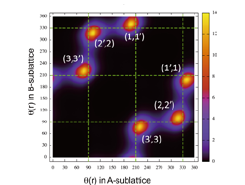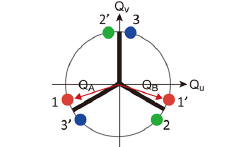Quadrupole Orders in Heavy Fermion Systems
Tsunetsugu Group
Heavy fermion compounds PrT2Zn20 (T=Ir, Rh) exhibit an unidentified phase transition at very low temperature of order 0.1K, and this is supposed to be an antiferro-quadrupole ordering. Rare-earth ions Pr3+ on the diamond sublattice have the electron configuration (4f)2 and this system is one of the rare cases that the local ionic ground state is a non-Kramers doublet, the degeneracy of which is not related to time-reversal symmetry. This log 2 entropy of Pr ion is released due to inter-site interactions and this is expected to lead to an antiferro order of electric quadrupoles experimentally observed below the transition temperature. First we had investigated this problem by a phenomenological approach [1]. Only two components Q=(Qu,Qv) of quadrupole moments are active within the ground-state doublet, and we constructed their Landau free energy based on symmetry analysis. Bond direction to nearest-neighbor sites imposes that only the isotropic coupling Qi・Qj is allowed. These seem to imply that the effective model is the antiferro plane rotor model that is known to exhibit a phase transition belonging to the O(2) universality class. However, cubic symmetry around the Pr site is transferred to Z3 symmetry in the internal two-dimensional Q space, and a special feature in our Landau free energy is the presence of a Z3 anisotropy term in the Q space. This anisotropy distinguishes the quadrupole physics from a seemingly similar spin system, in which the time-reversal symmetry prohibits the Z3 anisotropy.

Fig. 1. Monte-Carlo result of the pair distribution of nearest-neighbor order parameters, Q(r) = (cos θ(r), sin θ(r)) in the ordered phase. Index pair (1,1’), etc., represents the directions of the local order parameters in the two-sublattice shown in Fig. 2. Six peaks correspond to the six domains in the ordered phase, the multiplicity of which comes from Z3 symmetry in the Q space and Z2 symmetry of exchanging sublattices.

Fig. 2. Schematic picture of order parameters. Bold black lines show soft directions of the Z3 anisotropy. The primary order parameter is QA– QB, while the secondary order parameter is QA + QB. In each of the six domains, QA points to the corresponding direction n or n’ (n=1,2,3) and QB points to its partner direction n’ or n.
We used a mean-field approach to the Landau theory as well as to a microscopic model for Pr ions and found a phase transition to an antiferro ordered phase. The order parameter is the staggered Q component, but unexpectedly it does not point along a soft direction of the Z3 anisotropy but is rotated by 90 degrees. The Z3 anisotropy induces a secondary order parameter, and it is the uniform Q component pointing to a hard direction [1]. An important discovery is that the susceptibility of the secondary order parameter diverges faster than that for the primary order parameter upon approaching the transition temperature in the ordered phase [1]. This may explain the observed singularity in the ultrasound experiments.
We continued our study and investigated the effects of thermal fluctuations on this transition. We have performed classical Monte-Carlo simulations for our effective model and compared the results with those for the antiferromagnetic 3-state Potts model on bipartite lattices. Finite-size scaling analysis shows that the transition belongs to the O(2) universality class in three dimensions, which is consistent with simulations for the 3-state Potts model. The difference is about the spatial configuration of order parameter. The 3-state Potts antiferromagnet has a thermodynamic degeneracy in the ground state, and several exotic states have been proposed for the ordered phase. In our results, the local order parameters do not have esoteric macroscopic configurations aside from usual thermal fluctuations. The calculated pair distribution function of local Q direction between nearest-neighbor sites clearly demonstrates that the spatial configuration agrees with the mean-field result. Our result disproves most of the proposals for the Potts model, but the so-called permutationally symmetric sublattice state may be consistent after coarse graining. Understanding the critical behavior of the secondary order parameter is an interesting open issue and needs further investigation.
References
- [1] K. Hattori and H. Tsunetsugu, J. Phys. Soc. Jpn. 83, 034709 (2014).
